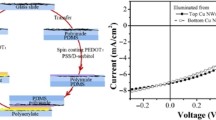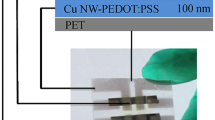Abstract
Applying copper nanowires (CuNWs) composite transparent conductive electrode (CTCE) as transparent conductive anode, a flexible organic light-emitting device (OLED) is demonstrated in this paper. Ultralong CuNWs were synthesized by a simple hydrothermal method. The random conductive grid of CuNWs was transferred to the surface of flexible substrates by vacuum filtration method. In order to reduce the surface roughness and improve work function, polymethyl methacrylate (PMMA) solution and poly(3,4-ethylenedioxythiophene):poly(styrenesulfonate) (PEDOT:PSS) solution were spin-coated on the surface of CuNW transparent conductive electrode (TCE) in turn. The CuNW/PMMA/PEDOT:PSS CTCE was applied to an OLED, and the experiment shows that the OLED was of high efficiency. On comparing the OLED with PEDOT:PSS TCE, the maximum brightness and maximum current density of the OLED with CuNW/PMMA/PEDOT:PSS CTCE were increased by 104% and 4 times, respectively.






Similar content being viewed by others
References
Liu YF, Feng J, Zhang YF et al (2014) Improved efficiency of indium-tin-oxide-free flexible organic light-emitting devices. Org Electron 15:478–483
Xiang C, Koo W, So F et al (2013) A systematic study on efficiency enhancements in phosphorescent green, red and blue microcavity organic light emitting devices. Light Sci Appl 2:e74-1–e74-7
Lozano G, Louwers DJ, Rodríguez SR et al (2013) Plasmonics for solid-state lighting: enhanced excitation and directional emission of highly efficient light sources. Light Sci Appl 2:e66-1–e66-7
Kumar A, Zhou C (2010) The race to replace tin-doped indium oxide: which material will win? ACS Nano 4:11–14
Sachse C, Lars MM, Bormann L et al (2013) Transparent, dip-coated silver nanowire electrodes for small molecule organic solar cells. Org Electron 14:143–148
Dan B, Irvin GC, Pasquali M (2009) Continuous and scalable fabrication of transparent conducting carbon nanotube films. ACS Nano 3:835–843
Unalan HE, Fanchini G, Kanwal A et al (2006) Design criteria for transparent single-wall carbon nanotube thin-film transistors. Nano Lett 6:677–682
Bu IY (2013) Highly conductive and transparent reduced graphene oxide/aluminium doped zinc oxide nanocomposite for the next generation solar cell applications. Opt Mater 36:299–303
Xu M, Qi J, Li F et al (2018) Transparent and flexible tactile sensors based on graphene films designed for smart panels. J Mater Sci 53:9589–9597. https://doi.org/10.1007/s10853-018-2216-5
Xur R, Wang X, Zhang M et al (2016) Transparent stretchable composite conductor based on silver nanowires with hybrid structure. J Mater Sci 51:7211–7219. https://doi.org/10.1007/s10853-016-0002-9
Zhu R, Kumar A, Yang Y et al (2011) Polarizing organic photovoltaics. Adv Mater 23:4193–4198
Na SI, Kim SS, Jo J et al (2008) Efficient and flexible ITO-free organic solar cells using highly conductive polymer anodes. Adv Mater 20:4061–4067
Lee SM, Kwon JH, Kwon S et al (2017) A review of flexible OLEDs toward highly durable unusual displays. IEEE Trans Electron Devices 64:1922–1931
LeeJ Lee I, Kim TS et al (2013) Efficient welding of silver nanowire networks without post-processing. Small 9:2887–2894
Yun S, Niu X, Yu Z et al (2012) Compliant silver nanowire–polymer composite electrodes for bistable large strain actuation. Adv Mater 24:1321–1327
Hu L, Kim HS, Lee JY et al (2010) Scalable coating and properties of transparent, flexible, silver nanowire electrodes. ACS Nano 4:2955–2963
Rathmell AR, Wiley BJ (2011) The synthesis and coating of long, thin copper nanowires to make flexible, transparent conducting films on plastic substrates. Adv Mater 23:4798–4803
Rathmell AR, Bergin SM, Hua YL et al (2010) The growth mechanism of copper nanowires and their properties in flexible, transparent conducting films. Adv Mater 22:3558–3563
Wu H, Hu L, Rowell MW et al (2010) Electrospun metal nanofiber webs as high-performance transparent electrode. Nano Lett 10:4242–4248
Li S, Chen Y, Huang L et al (2014) Large-scale synthesis of well-dispersed copper nanowires in an electric pressure cooker and their application in transparent and conductive networks. Inorg Chem 53:4440–4444
Sachse C, WeiB N, Gaponik N et al (2013) ITO-free, small-molecule organic solar cells on spray-coated copper-nanowire-based transparent electrodes. Adv Energy Mater 4:1300737-1–1300737-6
Hu W, Wang R, Lu Q et al (2014) An elastomeric transparent composite electrode based on copper nanowires and polyurethane. J Mater Chem C 2:1298–1305
Kholmanov IN, Domingues SH, Chou H et al (2013) Reduced graphene oxide/copper nanowire hybrid films as high-performance transparent electrodes. ACS Nano 7:1811–1816
Won Y, Kim A, Lee D (2014) Annealing-free fabrication of highly oxidation-resistive copper nanowire composite conductors for photovoltaics. NPG Asia Mater 6:e105-1–e105-9
Cheng Y, Wang S, Wang R et al (2014) Copper nanowire based transparent conductive films with high stability and superior stretchability. J Mater Chem C 2:5309–5316
Wang Y, Liu P, Zeng B et al (2018) Facile synthesis of ultralong and thin copper nanowires and its application to high-performance flexible transparent conductive electrodes. Nanoscale Res Lett 13:78-1–78-10
Chu CR, Lee C, Koo J et al (2016) Fabrication of sintering-free flexible copper nanowire/polymer composite transparent electrodes with enhanced chemical and mechanical stability. Nano Res 9:2162–2173
Vosgueritchian M, Lipomi DJ, Bao Z (2012) Highly conductive and transparent PEDOT:PSS films with a fluorosurfactant for stretchable and flexible transparent electrode. Adv Funct Mater 22:421–428
Zeng XY, Zhang QK, Yu RM et al (2010) A new transparent conductor: silver nanowire film buried at the surface of a transparent polymer. Adv Mater 22:4484–4488
Acknowledgements
This work is supported by the National Natural Science Foundation of China (Nos. 61571103 and 11775047), the Science and Technology Project Foundation of Zhongshan City (No. 2017B1016) and the Innovation Team of Zhongshan City (No. 170615151170710).
Author information
Authors and Affiliations
Corresponding author
Ethics declarations
Conflict of interest
The authors declare that they have no conflict of interest.
Rights and permissions
About this article
Cite this article
Wang, Y., Liu, P., Wang, H. et al. Flexible organic light-emitting devices with copper nanowire composite transparent conductive electrode. J Mater Sci 54, 2343–2350 (2019). https://doi.org/10.1007/s10853-018-2986-9
Received:
Accepted:
Published:
Issue Date:
DOI: https://doi.org/10.1007/s10853-018-2986-9




